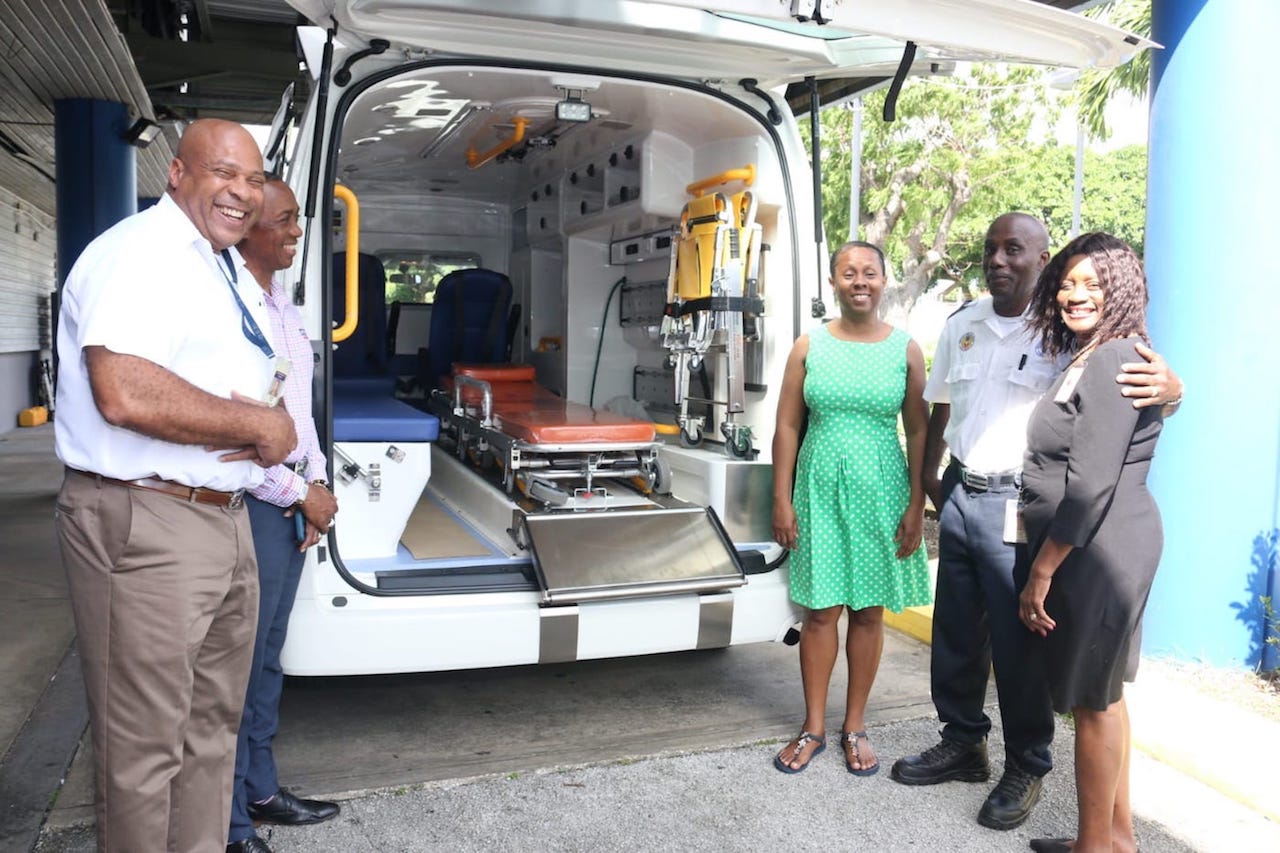Delays in Patient Care at Queen Elizabeth Hospital AED Impact Emergency Ambulance Service, says EAS Consultant Chief

January 4, 2024
Delays in patient care at the Accident and Emergency Department of Queen Elizabeth Hospital have impacted the Emergency Ambulance Service due to limited space and a shortage of stretchers.
Delays in patient care at the Accident and Emergency Department (AED) of the Queen Elizabeth Hospital (QEH) have affected the Emergency Ambulance Service (EAS), consultant head Dr David Byer said on Wednesday as he also called for the service to be decentralised.
The EAS consultant chief shed light on the difficulties faced in transferring patients from ambulance stretchers to gurneys in the AED due to limited space and a shortage of stretchers.
“Whenever we respond to a 511 call, we normally go for the patient and put them on a stretcher. Sometimes when get [to the QEH] we cannot transfer that patient from the ambulance stretcher to the AED gurney, given the number of patients there, so we have to leave the stretcher with the patient,” Dr Byer explained to reporters on the sidelines of the presentation of a new $200 thousand ambulance at the Services’ Wildey, St Michael headquarters.
“Now we have invested in some surplus stretchers but even sometimes those are also used up. Sometimes we have the personnel and we have ambulances but we have no stretchers or a limited number of stretchers and that impacts in terms of our response times.”
He suggested that fixing the problem was a bit more complicated than just buying additional stretchers, as space remained a problem.
“You may say: ‘Why not just buy lots of stretchers . . . 20, 30, maybe 40,’ but again, it is the topographic space,” said Dr Byer. “Where would we put them? Accident and Emergency is a fixed space. Usually, when they have all of the stretchers they are either parked in the corridors, sometimes double parked, etc.
“Even if we [bought] lots more stretchers, there would be a situation then where there may not be any space in the AED plant to move the patients in. So it is a little bit of a balance that we try to negotiate on a day-to-day basis, where we try to speak to the doctors there to see if there is anyone who can move off of a stretcher, but it sometimes impacts our capability to respond and also the response time.”
Dr Byer also identified the need to decentralise the EAS, with additional stations strategically placed which could enhance service delivery and improve response times in certain areas.
“[Currently], we operate two stations – one here in Wildey, with a decent response time to central and southern Barbados. The other station at Arch Hall, St Thomas allows for better response time to the west and north of Barbados. There are some areas I would say in southeastern Barbados [like in] St Philip, St John . . . which we service from the station [in Wildey] where the response time is something we would like to improve,” he said.
“We made a recommendation that somewhere, probably in the Six Roads, or some other areas in St Philip, be able to be used as a jump-off point which would aid in response time to those areas to render care. I am not sure how far that is in terms of the thinking but certainly it is something that we have made some level of recommendation to.”
Dr Byer also addressed road congestion issues affecting emergency response vehicles and efforts to modify ambulance sirens for better audibility.
“I will say with the best of intentions, the road leading to the City, from here [in Wildey to Collymore Rock] or so, is a pretty tight fit and even basically when the ambulance is making its way to the hospital for persons to pull to the left, there is not a lot of room to do that, so we do encounter some problems in terms of using this passageway to the QEH coming from the Christ Church area,” he said.
The EAS is also seeking to boost its manpower to meet public demand, with pending approval for increased personnel, Dr Byer said. He highlighted the popularity of the Barbados Community College’s Emergency Medical Technician course and its relevance not only for the public sector but also for workers in private services, the Barbados Defence Force, and the Barbados Prison Service.
The QEH’s new ambulance, obtained from dealers NASSCO, brings the service’s total fleet to 10, with two undergoing minor repairs. Another vehicle is on the way, according to the Minister of State in the Ministry of Health and Wellness Dr Sonia Browne.
Health officials have hailed the addition as a vital asset to enhance operations, especially in handling the surge of emergencies during the busy holiday season, underscoring the new vehicle’s contribution to existing capacity.
Dr Byer highlighted the importance of the new ambulance in ensuring effective response amid the increased calls, ranging from 1 000 to 1 500 per month.
“We have worked on this vehicle in terms of making sure it is of international standard. We have also learnt from the previous vehicles and improved to allow for our personnel to function in a better manner,” he said.
“It has been a busy Christmas and New Year period in terms of the calls. . . . That is something of an anomaly because normally, that is usually in the region of 1 200 or so. During the holiday season, we have more incidents happening, both traumatic in terms of motor vehicle accidents as well as interpersonal violence, as well as we have more illnesses based on chronic non-communicable diseases and so on.
“You would find more persons have crises relating to those illnesses and such a little bit more at the Christmas time, especially where people who may not take their medication, people indulge a little bit more, etc. and all that bears out in the traffic that we get.”
Expressing gratitude for the new addition, Dr Browne noted the seasonal influx of patients and the ambulance’s contribution to patient care.
While acknowledging the QEH’s ongoing challenges, she stressed the importance of utilising ambulances for genuine emergencies and highlighted efforts to continually upgrade staff training.
She said: “We have recognised the influx of patients, of course, over the holiday season which is not unusual but the ambulance will certainly add to patient care. We recognise the issues as well and we are happy to say that we have been very open with you about what the hospital is going through. The ambulance service is a key part of how we treat patients and we are grateful that it has come at this opportune moment.
“We are expecting another one relatively soon . . . [but] I have to say the ambulances are here for emergency purposes. Often, we have patients calling the ambulance service for what could be deemed not necessarily emergent but luckily we have very well-trained staff. In association with the Barbados Community College, we are making sure to upgrade the staff continually – hoping to get new staff in as well but this is another stop towards patient care.” (RG)


